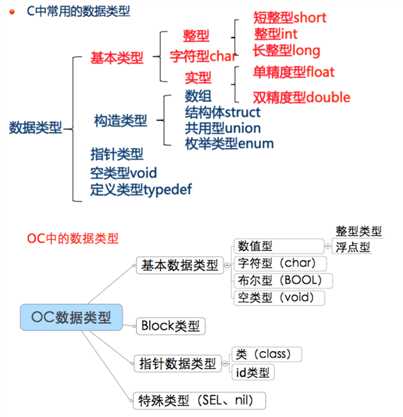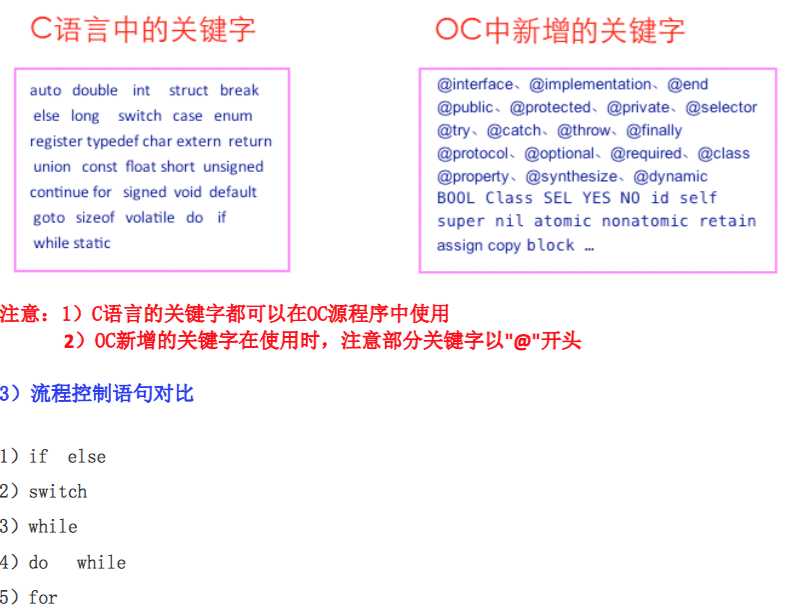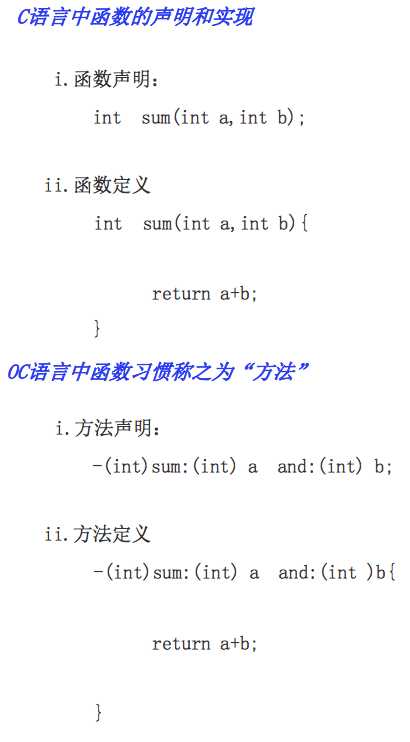Step by step !
1.NS常用的缩写
|
Prefix |
Frameworks |
|
AB |
AddressBook / AddressBookUI |
|
AC |
Accounts |
|
AD |
iAd |
|
AL |
AssetsLibrary |
|
AU |
AudioUnit |
|
AV |
AVFoundation |
|
CA |
CoreAnimation |
|
CB |
CoreBluetooth |
|
CF |
CoreFoundation / CFNetwork |
|
CG |
CoreGraphics / QuartzCore / ImageIO |
|
CI |
CoreImage |
|
CL |
CoreLocation |
|
CM |
CoreMedia / CoreMotion |
|
CV |
CoreVideo |
|
EA |
ExternalAccessory |
|
EK |
EventKit / EventKitUI |
|
GC |
GameController |
|
GLK |
GLKit |
|
JS |
JavaScriptCore |
|
MA |
MediaAccessibility |
|
MC |
MultipeerConnectivity |
|
MF |
MessageUI |
|
MIDI |
?CoreMIDI |
|
MK |
?MapKit |
|
MP |
?MediaPlayer |
|
NK? |
?NewsstandKit |
|
NS? |
?Foundation, AppKit, CoreData |
|
PK |
?PassKit |
|
QL |
?QuickLook |
|
SC |
?SystemConfiguration |
|
Se |
?Security |
|
SK |
?StoreKit / SpriteKit |
|
SL |
?Social |
|
SS |
?Safari Services |
|
TW |
|
|
UI? |
?UIKit |
|
UT |
?MobileCoreServices |



@interface、@implementation、@end
@public、@protected、@private、@selector
@try、@catch、@throw、@finally
@protocol、@optional、@required、@class
@property、@synthesize、@dynamic
BOOL Class SEL YES NO id self super nil atomic nonatomic retain assign copy block …
4.方法调用以及基础语法
#import <Foundation/Foundation.h>
?
// - 表示动态方方法
// +表示静态方法
@interface TestClass : NSObject
{
@public
? ? //下划线开头
? ? NSString * _name;
? ? int _age;
}
?
@property NSString * NickName;
?
+(void) staticSayHello;
-(void) SayHello;
?
+(double) staticTestWithParams:(int) num ThisIsWord:(int) num2;
?
@end
?
//实现上文中的方法才可以调用
@implementation TestClass
?
//实现构造函数
-(id)init
{
? ? if (self = [super init]) {
? ? ? ? NSLog(@"初始化构造函数...");
? ? }
? ? returnself;
}
-(id)initWithNickname:(NSString*)nickName
{
? ? if (self = [super init]) {
? ? ? ? NSLog(@"带有参数的构造 %@",nickName);
? ? }
? ? returnself;
}
-(id)initAgeAndNickname:(int)age andName :(NSString*)name
{
? ? if (self =[super init]) {
? ? ? ? NSLog(@"带有双参数的构造 %d +++ %@",age,name);
? ? }
? ? returnself;
}
?
?
-(void) SayHello
{
? ? NSLog(@"Name is %@ and age is %d",_name,_age);
}
+(void)staticSayHello{
? ? NSLog(@"Static Call SayHello must call by Class ..");
}
+(double)staticTestWithParams:(int)num ThisIsWord:(int) num2
{
? ? NSLog(@"%d +========+++=%d",num,num2);
? ? return num;
}
@end
?
int main(int argc, const char * argv[]) {
?? ?
? ? TestClass* test = [[TestClassalloc] initAgeAndNickname:21andName:@"xiaonian"];
?? ?
? ? test->_name = @"Hello World";
? ? test->_age = 21;
?? ?
? ? [test SayHello];//Call Method
? ? [TestClassstaticSayHello];//Casll Static Method
? ? [TestClassstaticTestWithParams:123456ThisIsWord:890123];
?? ?
? ? NSLog(@"--------分隔符---------");
?? ?
? ? Class c = [TestClass class];
? ? NSLog(@"%p",c);
? ? //0x100004708
?? ?
? ? NSLog(@"--------分隔符-@SEL--------");
? ? SEL sel = @selector(SayHello);
? ? [test performSelector:sel];
? ? [test performSelector:@selector(SayHello)];
? ? if ([test respondsToSelector:sel]) {
? ? ? ? NSLog(@"%@",@"可以相应sel--sayhello");
? ? }
? ? NSLog(@"--------分隔符-@property--------");
?? ?
? ? [test setNickName:@"xiaonian"];
? ? NSString* nickName = [test NickName];
? ? test.NickName = @"xiaonian2";
? ? NSString* nickName2 = test.NickName;
? ? NSLog(@"%@ and %@",nickName,nickName2);
?? ?
? ? return 0;
}
? ??Class c = [TestClass class];
? ? NSLog(@"%p",c);
? ? //0x100004708
? ? SEL:全称selector 一种用来表示方法名类型的数据类型(方法名)。
? ? SEL类型作用: 1)可以定义变量 ? ? ? 2)可以用来作为方法的形参 ? ?3)可以用来作为方法的实参
? ? 类中方法存储的原理: 1)类里面的方法都是被转换成SEL变量进行存储的。 2)当类声明一个对象,对象调用方法的时候,系统会把这个方法转换成SEL,然后拿这个SEL到类 方法中去匹配。
? ??SEL sel = @selector(SayHello);
? ? [test performSelector:sel];
? ? [test performSelector:@selector(SayHello)];
?
13.@property 只能在@interface中定义
? ??[test setNickName:@"xiaonian"];
? ? NSString* nickName = [test NickName];
? ? test.NickName = @"xiaonian2";
? ? NSString* nickName2 = test.NickName;
? ? NSLog(@"%@ and %@",nickName,nickName2);
?
?
14.关于自定义构造函数必须以init开头,在@implement中实现如下
-(id)init
{
? ? if (self = [super init]) {
? ? ? ? NSLog(@"初始化构造函数...");
? ? }
? ? returnself;
}
-(id)initWithNickname:(NSString*)nickName
{
? ? if (self = [super init]) {
? ? ? ? NSLog(@"带有参数的构造 %@",nickName);
? ? }
? ? returnself;
}
-(id)initAgeAndNickname:(int)age andName :(NSString*)name
{
? ? if (self =[super init]) {
? ? ? ? NSLog(@"带有双参数的构造 %d +++ %@",age,name);
? ? }
? ? returnself;
}
?
?
?
?
原文:http://www.cnblogs.com/Keyle/p/4959338.html